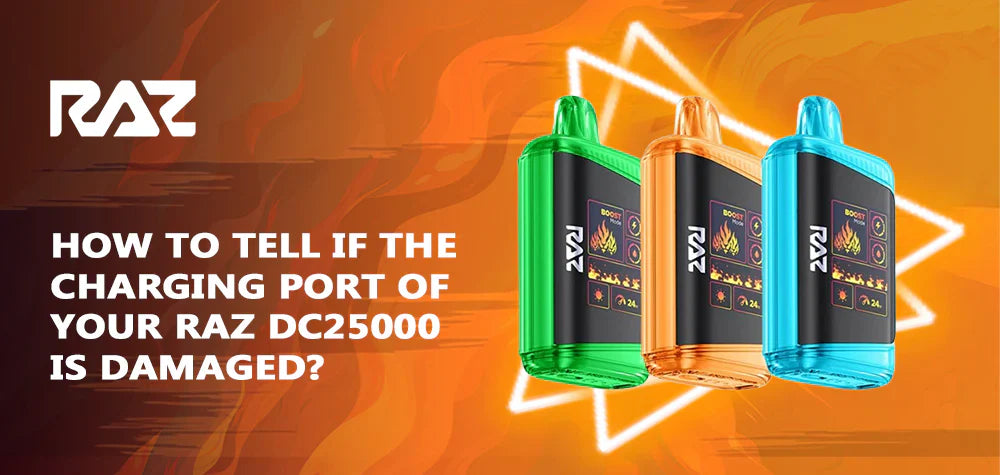
How To Tell If The Charging Port Of Your Raz DC25000 Is Damaged?
The charging port is a critical component of your RAZ DC25000 vape device, responsible for delivering power safely and efficiently to the internal battery. Damage or malfunction in this small but vital part can lead to a range of issues, including failure to charge, inconsistent power delivery, or even safety hazards such as overheating. Knowing how to tell if the charging port of your RAZ DC25000 is damaged is essential for maintaining device performance and avoiding potential risks. This article provides a detailed, professional guide to help you identify charging port damage, understand its implications, and take appropriate action.
Understanding the Role of the Charging Port in the RAZ DC25000
The RAZ DC25000 uses a USB-C charging port located at the bottom of the device. This port connects the vape to a power source via a USB-C cable, enabling the internal 800mAh rechargeable battery to replenish its charge. Because the device relies on this port for all charging operations, any damage or obstruction can disrupt the charging process, leading to performance issues or safety concerns.
The charging port's design includes delicate internal contacts and pins that must maintain a secure connection with the charger. Over time, wear and tear, physical impacts, or exposure to dust, lint, or e-liquid residue can impair this connection. Recognizing early signs of port damage can prevent further complications.
Common Symptoms Indicating a Damaged Charging Port
Loose or Wobbly Connection
One of the first signs that the charging port may be damaged is a loose or unstable connection when plugging in the USB-C cable. If the cable does not fit snugly or feels wobbly inside the port, it suggests that internal components may be bent, worn out, or broken. This loose fit can cause intermittent charging or prevent the device from charging altogether.
Inconsistent or Intermittent Charging
If your RAZ DC25000 charges only sporadically or stops charging when the cable is moved slightly, this inconsistency often points to damage within the charging port. The internal pins or contacts might be misaligned or partially broken, causing the device to lose connection intermittently.
Failure to Charge or No LED Indicators
When the device shows no signs of charging—such as the absence of LED lights or screen activity—despite using a known-good cable and power source, the charging port could be at fault. This failure may also be accompanied by the device not responding at all when plugged in.
Slow Charging
A damaged charging port can restrict the flow of power, resulting in significantly slower charging times than usual. If you notice that your RAZ DC25000 takes much longer to charge, even with the correct charger and cable, the port may be compromised.
Overheating While Charging
If the device or the charging port area becomes excessively hot during charging—a condition known as overheating while charging—this can be a serious indicator of port damage or malfunction. Overheating suggests poor electrical contact or short circuits within the port, which can degrade battery health and pose safety risks.
Inspecting the Charging Port for Physical Damage or Debris
Before concluding that the charging port is damaged, it is important to perform a careful visual and physical inspection. Use a bright light and magnifying glass if necessary to look inside the port for any visible signs of damage such as bent or broken pins, corrosion, or accumulation of dust, lint, or e-liquid residue.
Debris inside the port is a common cause of charging problems and can mimic symptoms of physical damage. Cleaning the port gently with compressed air or a soft wooden toothpick can often restore proper function. However, if physical damage is evident, cleaning will not resolve the issue.
Diagnosing Charging Port Damage: Step-by-Step Approach
Start troubleshooting by eliminating other potential causes of charging failure. Test the device with a different USB-C cable and power adapter to ensure the problem is not due to faulty accessories. If the device still does not charge or exhibits symptoms like intermittent charging or overheating while charging, the charging port is likely the culprit.
Next, examine the port carefully for signs of physical damage or debris. If the port appears damaged or cleaning does not improve charging behavior, it is reasonable to conclude that the port is compromised.
Risks and Consequences of a Damaged Charging Port
A damaged charging port not only affects your device's ability to charge but can also lead to more serious problems. Poor electrical connections can cause the device to overheat while charging, accelerating battery degradation and increasing the risk of battery swelling or even fire hazards. Additionally, a faulty port can cause erratic device behavior, such as unexpected shutdowns or failure to power on.
Using a device with a damaged charging port is unsafe and can shorten the lifespan of your RAZ DC25000. It is advisable to stop using the device if you suspect port damage and seek a replacement or professional repair.
Preventative Measures to Protect Your Charging Port
To minimize the risk of charging port damage, always handle your RAZ DC25000 with care. Avoid forcing the charging cable into the port or charging in environments where dust, moisture, or e-liquid residue can accumulate. Regularly inspect and clean the charging port gently to prevent buildup that can obstruct connections.
When charging, use only the original or high-quality compatible USB-C cables and chargers, and avoid charging for excessive periods to prevent stress on the port and battery.
What to Do If Your Charging Port Is Damaged
Since the RAZ DC25000 is a disposable vape device with integrated batteries and circuitry, repairing a damaged charging port is generally not feasible or recommended for users. Attempting to open or fix the device can cause further damage or safety risks.
If you confirm that the charging port is damaged, the safest course of action is to discontinue use and replace the device. If the device is still under warranty or recently purchased, contact the seller or manufacturer for possible exchange options.
Conclusion
Identifying a damaged charging port on your RAZ DC25000 is crucial for maintaining device safety and performance. Signs such as a loose connection, inconsistent charging, failure to charge, slow charging, or overheating while charging strongly suggest port issues. Careful inspection and troubleshooting can help confirm the problem, but due to the device's design, replacement is usually the best solution.
By understanding these indicators and taking proactive steps to protect the charging port, you can ensure a safer and more reliable vaping experience with your RAZ DC25000.


